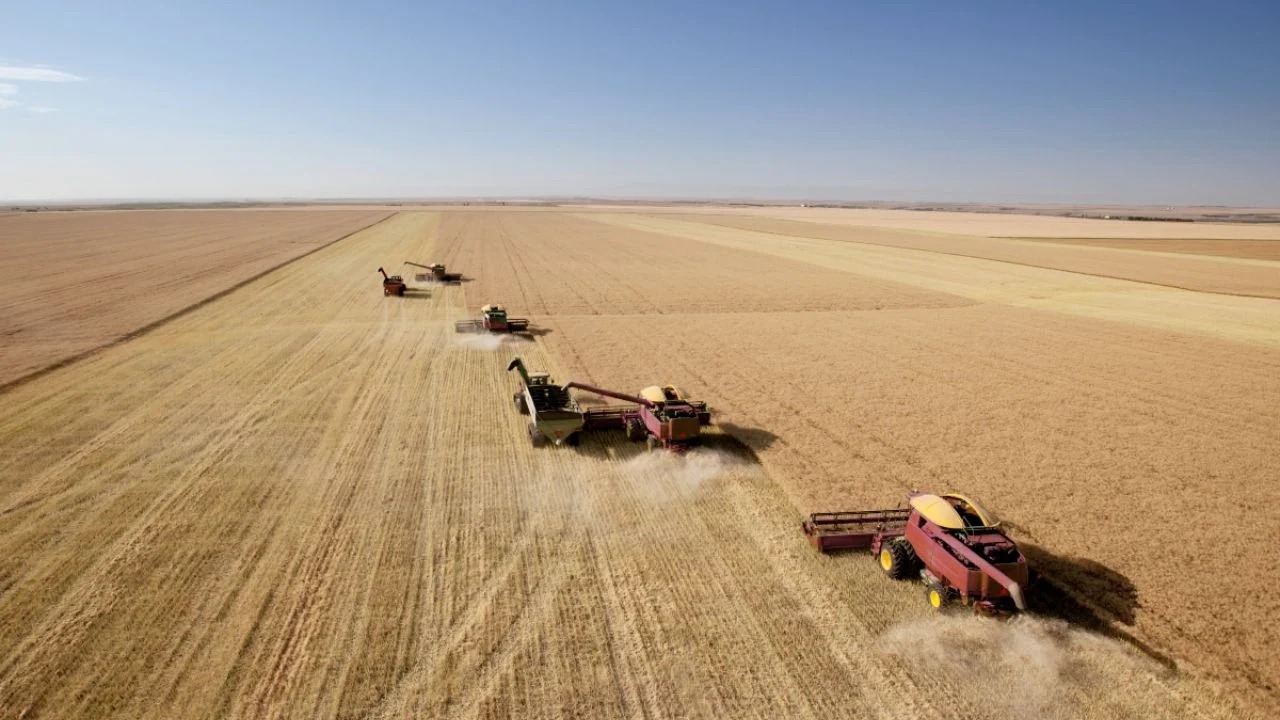

Finance
How Much Is Crop Insurance
Published: November 13, 2023
Looking to protect your crops? Find out how much crop insurance costs and secure your finances with comprehensive coverage.
(Many of the links in this article redirect to a specific reviewed product. Your purchase of these products through affiliate links helps to generate commission for LiveWell, at no extra cost. Learn more)
Table of Contents
- Introduction
- Importance of Crop Insurance
- Factors Determining Crop Insurance Costs
- Types of Crop Insurance Policies
- Premium Subsidies and Discounts
- Crop Insurance Rates and Premiums
- Factors Affecting Premium Rates
- Evaluating Crop Insurance Coverage
- How to Apply for Crop Insurance
- Frequently Asked Questions
- Conclusion
Introduction
Crop insurance plays a crucial role in safeguarding farmers’ livelihoods and ensuring food security in the face of unpredictable weather patterns and natural disasters. As farmers face increasing risks and uncertainties, crop insurance provides a form of financial protection that can help mitigate losses and provide much-needed stability.
It is estimated that crop insurance covers around 90% of insurable agricultural land in the United States, making it an essential tool for farmers to manage their risks. But how does crop insurance work, and how is the cost determined? In this article, we will explore the importance of crop insurance and delve into the factors that influence its costs.
Crop insurance provides compensation for insured farmers when they experience losses due to factors such as droughts, floods, pests, or other natural disasters. By providing a safety net, it helps farmers recover from losses and maintain their operations. Additionally, crop insurance can provide protection against fluctuating market prices, ensuring farmers receive fair compensation for their products.
The cost of crop insurance varies based on various factors, including the type of policy, coverage level, location, and historical yield data. Insurers assess the risk associated with each farm and use actuarial principles to determine the premium rates. Premiums are typically paid on an annual basis and represent a fraction of the potential indemnity payment in case of a loss.
Types of crop insurance policies available include revenue-based, yield-based, or composite policies. These policies offer different levels of protection and allow farmers to choose the coverage that best suits their specific needs. Each policy has its own set of rates and premiums, which are determined based on historical data and projected risks.
Government programs play a significant role in supporting crop insurance. The federal government provides premium subsidies and discounts to make insurance more affordable for farmers. The level of subsidy varies depending on factors such as the coverage level, type of policy, and the farmer’s risk management history.
Understanding the factors that influence crop insurance rates and premiums is essential for farmers to make informed decisions about their coverage. Factors such as crop type, location, past losses, and the chosen coverage level can all impact the cost of insurance. Farmers can work with insurance agents or use online tools to evaluate their options and select the policy that best aligns with their risk management strategy.
In the following sections, we will further explore the various factors that affect the cost of crop insurance and provide insights on how farmers can evaluate their coverage options and apply for insurance.
Importance of Crop Insurance
Crop insurance is of paramount importance for farmers as it provides them with a safety net against the inherent risks associated with agricultural production. Here are several key reasons why crop insurance is crucial:
- Risk Mitigation: Agriculture is highly susceptible to various risks, including adverse weather conditions, pests, diseases, and market price fluctuations. Crop insurance offers protection to farmers by compensating them for losses incurred due to these factors. It ensures that farmers can recover and continue their operations, even in the face of significant setbacks.
- Financial Stability: Crop yield uncertainties and market volatility can significantly impact farmers’ incomes. Crop insurance helps to stabilize farmers’ finances by providing financial support when yield or market prices fall below predetermined levels. This stability is crucial for farmers’ livelihoods and supports rural economies.
- Food Security: The global population is increasing, and so is the demand for food. Crop insurance plays a vital role in ensuring food security by incentivizing farmers to continue producing crops even in challenging circumstances. By stabilizing farm incomes, crop insurance helps to maintain a reliable supply of quality food for consumers.
- Lender Requirement: Farmers often rely on loans and credit to finance their farming operations. Lenders typically require farmers to have crop insurance coverage as a condition for obtaining loans. Crop insurance provides lenders with the assurance that, in the event of a catastrophic event, the farmer will be able to repay the loan, reducing financial risk for both parties.
- Risk Management Tool: Crop insurance is an effective risk management tool that allows farmers to make informed decisions about their agricultural practices. By providing a safety net, farmers can explore innovative techniques, adopt new technologies, and invest in efficient farming practices without the fear of losing their investments in case of unexpected events.
The importance of crop insurance becomes even more evident in the context of climate change. With the increasing frequency and severity of extreme weather events, farmers face higher risks and uncertainties. Crop insurance helps farmers adapt to these changing conditions and provides them with the confidence to continue farming sustainably.
Overall, crop insurance is a vital tool that supports the long-term sustainability of the agricultural sector. By offering financial protection, stability, and risk management, crop insurance ensures the well-being of farmers, food security for communities, and economic stability for rural areas.
Factors Determining Crop Insurance Costs
The cost of crop insurance is influenced by several factors that insurers take into consideration when determining premium rates. Understanding these factors is crucial for farmers to assess their insurance needs and make informed decisions. Here are the key factors that impact crop insurance costs:
- Crop Type: Different crops have varying levels of risk and potential for loss. Insurers consider the historical data on crop yields, susceptibility to pests and diseases, and market trends to determine the premium rates for each crop. Crops with higher risks typically have higher insurance costs.
- Geographical Location: The location of the farm plays a significant role in determining insurance costs. Factors such as climate, soil conditions, and historical weather patterns can vary from region to region. Farms located in areas prone to natural disasters or with a history of high crop losses may have higher premium rates than farms in more favorable locations.
- Coverage Level: The chosen coverage level directly impacts the cost of crop insurance. Insurers offer various coverage options, ranging from catastrophic coverage, which provides minimal protection, to higher levels of coverage that offer more comprehensive protection. Higher coverage levels come with higher premiums due to the increased potential indemnity payout.
- Historical Yields: Insurers assess a farm’s historical yields over a period of time to determine the level of risk associated with crop production. Farms with more consistent and higher yields are typically seen as lower risk and may have lower premium rates compared to farms with lower yields or large fluctuations in production.
- Risk Management History: Insurers also consider a farmer’s risk management history when calculating premiums. Farmers who have implemented effective risk mitigation strategies, such as crop rotations, pest management practices, or irrigation systems, may be eligible for discounts on their insurance premiums.
- Previous Losses: Farms with a history of significant crop losses may face higher insurance costs. Insurers take into account past losses when determining premium rates, as it indicates a higher level of risk associated with the farm’s production. However, farmers who have experienced losses may also qualify for higher insurance coverage or additional risk management support.
- Government Programs: Government programs play a significant role in reducing the cost of crop insurance for farmers. The federal government provides premium subsidies, which lower the cost of insurance for farmers. The level of subsidy varies depending on the chosen coverage level and the type of policy. Farmers should explore available government programs and subsidies to maximize their insurance benefits.
It is important for farmers to evaluate their specific circumstances, including their crop choices, location, and risk management practices, to determine the most appropriate and cost-effective insurance coverage for their farming operations. Working with insurance agents or utilizing online tools can help farmers assess their options and compare premium rates from different insurers.
By understanding the factors that determine crop insurance costs, farmers can make informed decisions about their coverage, effectively manage their risks, and protect their investments in agricultural production.
Types of Crop Insurance Policies
Crop insurance policies come in various types, each offering different levels of protection and coverage options. Farmers can choose the policy that best suits their needs and risk management strategies. Here are the main types of crop insurance policies available:
- Revenue Protection (RP): Revenue Protection is one of the most widely used crop insurance policies. It provides coverage based on the revenue of the insured crop, taking into account both yield and price fluctuations. RP policies protect against a decline in revenue due to low yields, low market prices, or a combination of both. The premium rates for RP policies are determined based on expected revenue and historical loss data.
- Yield Protection (YP): Yield Protection policies primarily focus on safeguarding farmers against declines in crop yields. YP policies provide coverage based on the expected yield of the insured crop and protect against yield losses due to various perils, such as drought, pests, or diseases. The premiums for YP policies are determined based on historical yield data and the level of coverage selected.
- Whole-Farm Revenue Protection (WFRP): WFRP is designed for farmers with diversified operations. This policy provides coverage for all revenue sources on the farm, including crops, livestock, and other agricultural commodities. WFRP offers flexible coverage options and considers the revenue from the entire farm, allowing farmers to manage risks across multiple commodities. Premium rates for WFRP policies are based on the farm’s historical revenue and the selected coverage level.
- Area Risk Protection Insurance (ARPI): ARPI policies provide coverage based on the average yield or revenue of a specific geographical area, rather than individual farm yields. It helps protect against widespread losses due to factors such as weather events or widespread pest and disease outbreaks. ARPI policies can be particularly beneficial for farmers in regions with highly correlated yields. Premium rates for ARPI policies are determined based on the historical data of the area.
- Catastrophic Coverage (CAT): CAT coverage is the minimum level of coverage available to farmers. It provides protection against yield losses greater than 50% at a fixed percentage of the expected yield. CAT policies have lower premiums but offer limited coverage and do not cover revenue losses or additional perils. This type of policy is often required to qualify for other farm programs.
It is important for farmers to carefully evaluate their farming operations, consider their risk tolerance, and assess the suitability of each type of policy. Farmers can work with crop insurance agents who can provide personalized guidance on the most appropriate policy for their specific needs.
It is worth noting that crop insurance policies may have specific endorsements or options that farmers can add to enhance their coverage. These endorsements may include provisions for prevented planting, replanting, or additional coverage for specific perils.
Overall, having a clear understanding of the different types of crop insurance policies and their coverage options allows farmers to make informed decisions and select the policy that best aligns with their risk management strategies and farming operations.
Premium Subsidies and Discounts
Crop insurance premiums can be a significant expense for farmers, but various government programs provide financial assistance to make insurance more affordable. These programs offer premium subsidies and discounts to help offset the cost of crop insurance. Here are the main ways in which farmers can benefit from premium subsidies and discounts:
- Premium Subsidies: The federal government provides premium subsidies, which directly reduce the amount farmers have to pay for their crop insurance premiums. The level of subsidy depends on the coverage level selected by the farmer. Typically, higher coverage levels receive higher subsidy percentages. For example, farmers who choose a higher coverage level may receive a subsidy of 50% or more, significantly reducing their out-of-pocket premium expenses.
- Beginning Farmers and Ranchers (BFR) Benefits: The government recognizes the importance of supporting new farmers and ranchers by helping them access affordable crop insurance. Beginning farmers and ranchers can receive increased premium subsidies during their initial years of farming. These subsidies gradually decrease over time and provide a financial incentive for new farmers to obtain necessary coverage while establishing their operations.
- Multi-Peril Crop Insurance (MPCI) Premium Discounts: Insurers can offer premium discounts to farmers who purchase multiple policies or opt for additional coverage options. These discounts encourage farmers to diversify their risk management strategies and provide an opportunity for cost savings. Farmers should consult with their insurance agents to explore the availability of premium discounts based on their specific circumstances and policy choices.
- Conservation Compliance Discounts: Farmers who adhere to certain conservation practices on their land may qualify for premium discounts. These practices help conserve soil, water, and wildlife habitats. By implementing and certifying compliance with designated conservation practices, farmers can benefit from reduced crop insurance premiums as part of conservation programs.
- Supplemental Coverage Option (SCO) Premium Discounts: The SCO program is a government subsidy program that provides additional coverage for farmers who have purchased an underlying crop insurance policy. Premium discounts may be available for farmers who choose to enroll in SCO, enabling them to enhance their coverage at a reduced cost.
It is essential for farmers to be aware of and take advantage of these premium subsidies and discounts. Working closely with crop insurance agents or utilizing online tools can help farmers navigate the complexity of subsidy programs and select the most cost-effective coverage options.
Farmers should also keep in mind that premium subsidies and discounts can vary based on their geographical location, the chosen policy, and their individual farming circumstances. Staying informed about changes in subsidy programs and cost-sharing arrangements can help farmers maximize their benefits and reduce their crop insurance costs.
By utilizing premium subsidies and discounts, farmers can effectively manage their crop insurance expenses while ensuring they have adequate coverage to protect against potential losses.
Crop Insurance Rates and Premiums
Crop insurance rates and premiums are calculated based on various factors, including historical data, projected risks, and the type of policy chosen by the farmer. Understanding how these rates and premiums are determined is essential for farmers to accurately assess the cost of their insurance coverage. Here’s an overview of the key aspects related to crop insurance rates and premiums:
Actuarial Principles: Crop insurance rates are determined using actuarial principles, which involve analyzing historical data, yield expectations, market trends, and projected risks. The premium rates are designed to cover the overall cost of the insurance program, including indemnity payments and administrative expenses.
Rate Setting Process: Crop insurance rates are established by private insurance companies and approved by the government. Insurers use actuarial data and models to assess the risk associated with different crops, regions, coverage levels, and historical loss patterns. These factors influence the premium rates for each specific crop and policy.
Yield and Price Coverage: The two primary components that impact crop insurance premiums are yield coverage and price coverage. Higher levels of coverage for either yield or price result in higher premiums. Farmers can select the coverage levels that align with their risk management goals and budget.
Policy Costs: Crop insurance policies have associated administrative and underwriting costs, which contribute to the overall premium. These costs cover the expenses incurred by insurance companies in delivering and managing the insurance program, including processing claims, conducting inspections, and providing customer support.
Claim History and Loss Ratios: Historical loss experience, both at an individual farm level and industry-wide, can influence the premium rates. Farms with higher loss ratios (indemnity payments relative to premiums) may face higher rates due to increased risk perception. Similarly, regions or crops with sustained losses may also see higher premium rates to reflect the historical risk profile.
Geographical Variation: Crop insurance rates can vary based on the geographical location of the farm. Prices and risks associated with different crops may differ from region to region, impacting the premium rates. Factors such as climate, pests, disease prevalence, and historical yield patterns play a role in determining the rates for specific locations.
Government Subsidies: Premium subsidies provided by the government help offset a portion of the crop insurance premiums. The level of subsidy depends on the chosen coverage level and can significantly reduce the farmer’s out-of-pocket expenses. Farmers should consult with insurance agents or utilize online tools to understand the extent of subsidies available for their specific circumstances.
It is important for farmers to carefully evaluate their risk tolerance, farming practices, and financial ability when selecting the appropriate crop insurance coverage. By understanding the key factors influencing crop insurance rates and premiums, farmers can make informed decisions about their coverage options and manage their risk effectively.
Farmers are encouraged to consult with experienced crop insurance agents who can provide personalized guidance and help them navigate the complexities of the rate-setting process. By evaluating the cost of premiums alongside the potential benefits and risks, farmers can develop a comprehensive risk management strategy that protects their livelihoods and supports their long-term sustainability.
Factors Affecting Premium Rates
Several factors influence the premium rates of crop insurance policies. Understanding these factors is essential for farmers to accurately assess the cost of their insurance coverage and make informed decisions. Here are the key factors that can affect crop insurance premium rates:
- Crop Type: Different crops have varying levels of risk associated with them. Some crops may be more susceptible to pests, diseases, or weather-related hazards, which can impact premium rates. Crops with higher historical loss ratios or more significant risk factors may have higher premiums due to the increased likelihood of losses.
- Geographical Location: The location of the farm plays a crucial role in determining premium rates. Regions with higher incidences of natural disasters, pest infestations, or other risk factors may result in higher premiums. Similarly, areas with a history of lower historical yields or more volatile market conditions may also see higher premium rates.
- Coverage Level: The chosen coverage level directly impacts premium rates. Higher coverage levels offer more comprehensive protection, resulting in higher premiums. Farmers can select the coverage level that aligns with their risk management goals and financial capabilities.
- Historical Yields: Historical yield data is a key factor considered in pricing crop insurance. Farms with lower and more volatile historical yields may have higher premium rates due to the increased risk associated with crop production. Conversely, farms with higher and more stable historical yields may receive lower premium rates.
- Risk Management Practices: Farmers who implement effective risk management practices such as crop diversification, pest management practices, or irrigation systems can potentially receive premium discounts based on their risk mitigation efforts. Demonstrating good risk management practices and maintaining a positive loss history can contribute to lower premium rates.
- Previous Losses: Farms with a history of significant crop losses may face higher premium rates. Insurers take into account past loss experience when calculating premiums as it indicates a higher level of risk associated with the farm’s production. However, farmers who have experienced losses may also qualify for higher insurance coverage or additional risk management support.
- Government Subsidies: Government programs provide premium subsidies to reduce the cost of crop insurance for farmers. The level of subsidy varies depending on the chosen coverage level and the type of policy. Higher subsidy percentages can help lower the premium rates, making insurance more affordable for farmers.
- Market and Price Volatility: The volatility of crop prices can influence premium rates. Crops with higher market price fluctuations may have higher premium rates due to the increased potential for revenue losses. Insurers consider market trends and price risk when determining the insurance rates for different crops.
It is important for farmers to assess their individual circumstances, including crop choices, location, and risk management practices, to determine how these factors may impact their crop insurance premium rates. Working with knowledgeable crop insurance agents can provide valuable insights and guidance in understanding the specific risk factors and premium rates for different crops and regions.
By evaluating these factors and understanding their impact on premium rates, farmers can make informed decisions about their crop insurance coverage, effectively manage their risks, and protect their investments in agricultural production.
Evaluating Crop Insurance Coverage
Evaluating crop insurance coverage is a crucial step for farmers to ensure they have adequate protection against potential losses. Assessing the various aspects of coverage can help farmers make informed decisions and tailor their insurance policies to their specific needs. Here are key factors to consider when evaluating crop insurance coverage:
- Coverage Options: Understanding the different types of coverage options available is essential. Farmers should consider the specific risks they face, such as weather events, pests, or market volatility, and select coverage that addresses these risks effectively. Assessing the benefits and limitations of each policy type, such as revenue protection or yield protection, can help in determining the best fit for their farming operations.
- Coverage Level: The coverage level determines the proportion of losses that will be compensated. Evaluating the desired level of protection involves considering the farm’s financial situation, risk tolerance, and historical yield patterns. Farmers should balance the costs associated with higher coverage levels against the potential benefits of adequate protection.
- Exclusion and Limitations: Familiarizing oneself with any exclusions or limitations within the policy is essential. Certain events or conditions may be excluded from coverage, such as specific weather events or management practices. Understanding these exclusions can help farmers assess potential gaps in their coverage and explore supplemental options if necessary.
- Loss Calculation: Understanding how indemnity payments are calculated is crucial. Farmers should be aware of whether yield or revenue is used in loss calculations and how it aligns with their expected production and marketing strategies. Familiarity with loss calculation procedures ensures farmers have a clear understanding of the potential payment they may receive in the event of a covered loss.
- Costs and Budget: Assessing the costs associated with crop insurance is vital to ensure it fits within the farm’s budget. Farmers should consider the premium rates, deductibles, and any additional fees when calculating the total expense. Comparing quotes from different insurers and exploring government subsidy programs can help find the most cost-effective options.
- Complementary Risk Management: Evaluating how crop insurance fits into the overall risk management strategy is important. Farmers should consider whether additional risk management tools, such as diversification, hedging, or forward contracting, can supplement the effectiveness of crop insurance coverage based on their specific circumstances. Balancing different risk management strategies helps to create a comprehensive risk mitigation plan.
- Claim Process and Customer Service: Understanding the claim process and assessing the reputation of the insurer for prompt and fair claims handling is crucial. Farmers should review the insurer’s history of customer service, responsiveness, and ease of claims filing. Choosing an insurer with a strong track record of customer satisfaction can provide peace of mind during the claims process.
Farmers are encouraged to work closely with experienced crop insurance agents who can provide valuable guidance in evaluating coverage options and understanding the details of the policies. These agents have in-depth knowledge of crop insurance products and can help farmers assess their risks, navigate the intricacies of the policies, and select the most appropriate coverage for their farming operations.
By thoroughly evaluating crop insurance coverage, farmers can make informed decisions and ensure they have adequate protection to mitigate potential losses, safeguard their investments, and maintain their financial stability in the face of unforeseen events.
How to Apply for Crop Insurance
Applying for crop insurance is a straightforward process that involves a few key steps. Farmers should follow these steps to ensure a smooth application process and obtain the necessary coverage for their farming operations:
- Research and Evaluation: Start by researching and evaluating the different crop insurance options available. Understand the types of coverage, policy options, and endorsements that best align with your specific needs and risk management goals. Assess factors such as crop type, geographical location, historical yields, and market trends to determine the most suitable coverage options.
- Consult Crop Insurance Agents: Seek support and guidance from experienced crop insurance agents who specialize in agricultural insurance. These agents have comprehensive knowledge and can help assess specific risk factors, determine appropriate coverage levels, and navigate the complexities of the application process. They can provide personalized advice tailored to your farming operations.
- Gather Farm Information: Collect all relevant farm information necessary for the application process. This may include details about the crops to be insured, acreage, historical yields, past loss records, and other required documentation. Ensure that the information gathered is accurate and up to date.
- Choose an Approved Insurance Provider: Select an approved crop insurance provider to work with. These providers are authorized by the government and offer a range of crop insurance policies. The approved provider will facilitate the application process, answer any questions, and guide you through the paperwork.
- Complete the Application: Fill out the application form provided by the insurance provider. Provide all required information accurately and thoroughly. Be prepared to answer questions about your farming practices, coverage preferences, and relevant historical data. Double-check all information for accuracy before submitting the application.
- Pay Premium and Sign Documentation: Once the application is complete, you will receive premium payment instructions. Pay the required premium amount within the specified timeframe to secure your coverage. Additionally, review and sign all necessary documentation, including policy terms and conditions.
- Submit the Application: Submit the completed application and all supporting documents to the approved insurance provider. Ensure that the application is submitted before the specified deadline, taking into account any applicable deadlines for the specific crop and coverage year.
- Review and Update: Regularly review and update your crop insurance coverage to align with your evolving farming operations and risk management strategies. Assess and adjust coverage levels, endorsements, and other policy details as needed.
Remember that applying for crop insurance may have specific deadlines based on crop-specific deadlines and eligibility requirements. It is essential to stay informed about these deadlines to ensure timely application submission.
Crop insurance provides vital protection for farmers by offsetting potential losses and reducing financial risks. By following these steps and working closely with knowledgeable insurance agents, farmers can navigate the application process efficiently and secure the insurance coverage necessary to protect their livelihoods.
Frequently Asked Questions
Here are answers to some commonly asked questions about crop insurance:
- Who is eligible for crop insurance?
- What crops can be covered by crop insurance?
- How much does crop insurance cost?
- What does crop insurance cover?
- Are there any deadlines for applying for crop insurance?
- What is the claims process for crop insurance?
- Is crop insurance mandatory?
- Can I purchase crop insurance mid-season?
- How can I find an approved crop insurance agent?
- Can I change my crop insurance coverage?
Farmers who own or operate eligible crop-producing land are generally eligible for crop insurance. Consult with an approved insurance provider to determine specific eligibility criteria and requirements.
Crop insurance coverage is available for a wide range of crops, including major field crops, fruits, vegetables, and specialty crops. Coverage availability may vary by region and crop type. Check with your crop insurance agent or provider to determine the specific crops covered in your area.
The cost of crop insurance varies based on factors such as crop type, coverage level, geographical location, historical yields, and selected policy options. Premium rates are determined using actuarial principles and are influenced by government subsidies and discounts. Consult with your insurance agent or provider to get a precise quote tailored to your farming operation.
Crop insurance provides coverage against various perils, including but not limited to adverse weather conditions, drought, flood, fire, pests, and diseases. It can also offer protection against yield losses and revenue declines. The specific coverage details depend on the policy type and options chosen.
Yes, there are specific application deadlines for crop insurance. Deadlines vary by crop, geographical location, and policy year. It is crucial to be aware of these deadlines to ensure timely application submission. Contact your insurance agent or provider for information on applicable deadlines.
In the event of a covered loss, farmers must notify their insurance agent and provide documentation supporting the claim. The insurance provider will assess the claim based on the policy terms and conditions and issue an indemnity payment if the claim is approved. The claims process may involve field appraisals and inspections.
Crop insurance is generally not mandatory, but it may be required by lenders as a condition for obtaining loans or participating in certain government programs. Even if not mandatory, crop insurance is highly recommended as it helps protect farmers’ investments and provides stability in the face of potential losses.
Crop insurance policies must generally be purchased before the growing season begins. However, there may be provisions for purchasing coverage mid-season in some cases, such as for certain types of fruit tree coverage or certain changes in the farming operation. Consult your insurance agent or provider to determine if mid-season purchase options are available.
The U.S. Department of Agriculture’s Risk Management Agency (RMA) provides a list of approved crop insurance agents. You can visit the RMA website or contact your local Farm Service Agency (FSA) office for assistance in finding an approved agent.
Yes, farmers can adjust their crop insurance coverage on an annual basis. Changes to coverage, coverage levels, and policy options can be made before the application deadline for the upcoming crop year. It is essential to review and update coverage based on changes in farming practices and risk management goals.
If you have further questions or need specific information regarding crop insurance, it is recommended to reach out to an approved crop insurance agent or contact your insurance provider directly. They can provide personalized guidance and address any specific concerns you may have about crop insurance coverage.
Conclusion
Crop insurance is an indispensable tool for farmers seeking to mitigate risks and protect their livelihoods in the face of unpredictable challenges. It provides a safety net that helps farmers recover from crop losses caused by adverse weather, pests, diseases, or market fluctuations. By offering financial stability, crop insurance supports farmers in maintaining their operations, ensuring food security, and contributing to the overall stability of rural economies.
Understanding the factors that determine crop insurance costs, such as crop type, geographical location, coverage level, historical yields, and risk management practices, helps farmers make informed decisions about their coverage options. Farmers can work with crop insurance agents to evaluate their requirements, explore available policy types, and select the coverage that aligns with their specific needs.
Government programs provide premium subsidies and discounts to make crop insurance more affordable, making it accessible to a broader range of farmers. Farmers should take advantage of these subsidies and discounts, ensuring they receive the benefits they are eligible for.
Evaluating crop insurance coverage involves considering policy options, coverage levels, limitations, and costs. By thoroughly assessing their specific farming operations, risk tolerance, and budget, farmers can make sound decisions about the coverage that best suits their needs.
The application process for crop insurance involves conducting research, gathering necessary farm information, consulting with insurance agents, choosing an approved insurance provider, completing the application, paying premiums, and submitting the application before the deadline. Farmers should be aware of specific deadlines and consult with agents or providers to ensure a smooth application process.
By understanding the fundamentals of crop insurance, including coverage types, premium rates, eligible crops, and the claims process, farmers can effectively manage their risks and protect their investments. Regularly reviewing and updating the coverage helps ensure that the insurance remains aligned with changing farming practices and risk management strategies.
In summary, crop insurance provides vital financial protection and stability to farmers, safeguarding their operations and contributing to the overall resilience and sustainability of the agricultural sector. By utilizing crop insurance effectively, farmers can navigate the uncertainties of farming, manage their risks, and continue their essential role in providing food security for communities.














